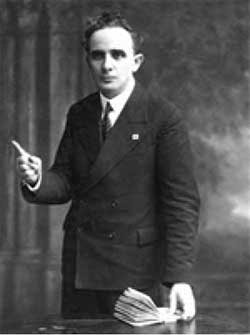George Jeffreys 1889-1962

George Jeffreys
It is no wonder that George Jeffreys became the founder and leader of the Britain’s Elim Pentecostal Alliance. He was arguably the most influential and gifted preacher that the British Pentecostal Movement has ever produced. Donald Gee’s record of him is revealing: ‘He had a voice like music, with sufficient Welsh intonation to add an inimitable charm.
His platform personality at times was magnetic. His face was appealing. Although lacking academic training he possessed a natural refinement that made him acceptable in all circles. He presented his message with a logical appeal and a note of authority that was compelling. With all that he was baptized in the Holy Spirit.’
George Jeffreys Converted in the Welsh revival
He was converted in the Welsh Revival on Nov. 20th 1904, with his brother Stephen, under the evangelistic ministry of Glassnant Jones. It was the provocation of Stephen’s son, Edward, who first received the Spirit and spoke in tongues that caused him to seek God for a deeper experience. Soon afterwards he received a personal healing from extreme physical frailty, a speech impediment and a developing facial paralysis. He was also baptised in the Holy Spirit and was soon preaching the Gospel publicly.
Training in Preston under Thomas Myerscough
At Cecil Polhill’s instigation he resigned from his job at the Co-operative Stores in Maesteg, and began a period of training at the Pentecostal missionary college in Preston under Thomas Myerscough’s leadership and was set apart for the ministry by the Independent Apostolic Church known as Emmanuel Christ Church, Maesteg, on the 13th Nov. 1912.
His early ministry
He helped his brother in a mission in Jan. 1913 and began to conduct small campaigns in Wales with increasing success. Attending the Sunderland convention in 1913 he was given opportunity to preach for Alexander Boddy and an Irish visitor immediately invited him to Ireland, offering to pay the fare.
Unfortunately, when the owners of the hall in Monaghan that was secured for the series of meetings, learned that he was a Pentecostal, they cancelled the booking! During a further invitation in 1915 to minister in Monaghan, Northern Ireland, George met a group of zealous young men and they joined together forming the Elim Evangelistic Band, registering it as the Elim Pentecostal Alliance. The members were Margaret Streight, R. E. (Ernest ) Darragh, William Henderson, and Frederick Farlow.
Initially they worked exclusively in Ireland, establishing his first church in Belfast in 1916. After this he founded the Elim Pentecostal Church and accepted many invitations in England, planting churches there from 1921.
With Stephen he conducted highly successful crusades in London and Hull before entering London in 1922. In this year the headquarters of Elim were moved to Clapham in S.W. London. “Elim Woodlands” was purchased and it also housed the Elim Bible College, with other local properties added for administration of the growing movement.
Growing success as an extaordinary evangelist
George spent the next ten years in sustained evangelistic activity with remarkable success. During this time his ministry enjoyed a fresh anointing causing a meteoric rise to fame across the land. His evangelistic and divine healing campaigns soon filled the largest public halls in the country. There were thousands of converts, scores of healings and dozens of churches planted. In Birmingham 10,000 converts were recorded. British Pentecostalism enjoyed a quantum leap forwards during this time.
In mainland Europe he was also a great success, seeing an astonishing 14,000 converts in Switzerland in the years 1934-36. He visited Sweden several times and was the main preacher at the European Pentecostal Conference in Stockholm in June 1939.
Growing concerns with Elim’s church government
He set up an Elim ministerial conference in 1933 but throughout the late 1930’s George was struggling with various methods of church government, making one change after another, until he found himself at variance with the governing conference in 1939. He finally resigned and left the Elim movement he founded in Nov. 1940 and began the Bible-Pattern Church Fellowship based in Nottingham.
His funeral drew a large congregation to the Kensington Temple, and it was a disappointment to his many friends in all sections of the Movement that the ceremony was kept exclusively within his own circle. In spite of the clouds that dimmed the evening glory of his years, George Jeffreys remains a stirring memory as the greatest British evangelist since George Whitefield and John Wesley.
For a time his brilliant gifts helped the whole Pentecostal testimony in the British Isles, and we salute him as one of our great pioneers and a notable gift of Christ to His Church.
Bibliography: Donald Gee, ‘These Men I Knew’ 1965; Desmond Cartwright art. ‘International Dictionary of Pentecostal and Charismatic Movements’ 2002.
Tony Cauchi
For further research



